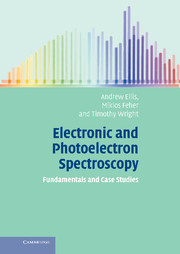Book contents
- Frontmatter
- Contents
- Preface
- List of journal abbreviations
- Part I Foundations of electronic and photoelectron spectroscopy
- Part II Experimental techniques
- Part III Case Studies
- Appendix A Units in spectroscopy
- Appendix B Electronic structure calculations
- Appendix C Coupling of angular momenta: electronic states
- Appendix D The principles of point group symmetry and group theory
- Appendix E More on electronic configurations and electronic states: degenerate orbitals and the Pauli principle
- Appendix F Nuclear spin statistics
- Appendix G Coupling of angular momenta: Hund's coupling cases
- Appendix H Computational simulation and analysis of rotational structure
- Index
- References
Appendix G - Coupling of angular momenta: Hund's coupling cases
Published online by Cambridge University Press: 05 June 2012
- Frontmatter
- Contents
- Preface
- List of journal abbreviations
- Part I Foundations of electronic and photoelectron spectroscopy
- Part II Experimental techniques
- Part III Case Studies
- Appendix A Units in spectroscopy
- Appendix B Electronic structure calculations
- Appendix C Coupling of angular momenta: electronic states
- Appendix D The principles of point group symmetry and group theory
- Appendix E More on electronic configurations and electronic states: degenerate orbitals and the Pauli principle
- Appendix F Nuclear spin statistics
- Appendix G Coupling of angular momenta: Hund's coupling cases
- Appendix H Computational simulation and analysis of rotational structure
- Index
- References
Summary
The discussion of angular momentum coupling in Appendix C focussed on electronic (orbital and spin) angular momenta. Other types of angular momenta may be present in molecules and their coupling to electronic angular momenta can have an important impact in spectroscopy. In this appendix rotational angular momentum is added to the pot and its interaction with electronic angular momenta is considered. The discussion is restricted to linear molecules, and several limiting cases, known as Hund's coupling cases, are briefly described.
Hund's case (a)
Hund's case (a) coupling builds upon the orbital + spin coupling already described in Appendix C. The orbital angular momenta in a molecule are assumed to be coupled to the internuclear axis by an electrostatic interaction and spin–orbit coupling leads to the spin angular momenta also precessing around the same axis. However, the spin–orbit coupling is not too strong to blur the distinction between orbital and spin angular momenta. Rotation in a linear molecule leads to rotational angular momentum and yields a vector R that is oriented perpendicular to the internuclear axis, as shown in Figure G.1.
In Hund's case (a) it is assumed that the interaction between the electronic and rotational angular momenta is weak, and hence the former (the orbital angular momentum L and the spin angular momentum S) continue to precess rapidly around the internuclear axis with projections whose sum is equal to Ω (= Λ + Σ).
- Type
- Chapter
- Information
- Electronic and Photoelectron SpectroscopyFundamentals and Case Studies, pp. 272 - 276Publisher: Cambridge University PressPrint publication year: 2005



